
Annona crassivenia is a species of plant in the family Annonaceae. It is native to Cuba. William Edwin Safford, the American botanist who first formally described the species, named it after the thick tertiary veins that interconnect the secondary veins of its leaves.
Goniothalamus nitidus is a species of plant in the family Annonaceae. It is native to Borneo. Elmer Drew Merrill, the American botanist who first formally described the species, named it after its shining leaves.
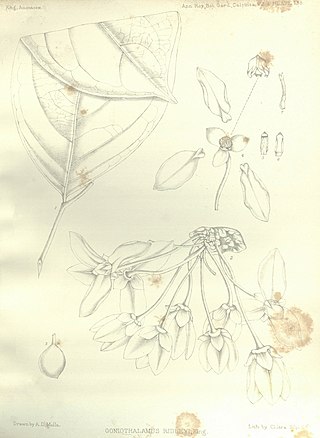
Goniothalamus ridleyi is a species of plant in the family Annonaceae. It is native to Borneo, Peninsular Malaysia, Sumatra and Thailand. George King, who first formally described the species, named it after the English botanist Henry Nicholas Ridley who collected the specimen King examined.

Hexalobus monopetalus is a species of plant in the family Annonaceae with the common name baboon's breakfast. It is native to Angola, Benin, Botswana, Burkina Faso, Cameroon, Central African Republic, Chad, Gambia, Ghana, Guinea, Guinea-Bissau, Ivory Coast, Liberia, Malawi, Mali, Mozambique, Namibia, Niger, Nigeria, Senegal, South Africa, Sudan, Tanzania, Togo, Uganda, Zambia, Zaire and Zimbabwe. Achille Richard, the French botanist who first formally described the species, using the basionym Uvaria monopetala, named it after its petals which are fused at their base.
Huberantha flava is a species of plant in the family Annonaceae. It is native to The Philippines. Elmer Drew Merrill the American botanist who first formally described the species, using the basionym Polyalthia flava, named it after its brilliant yellow flowers.
Mitrephora alba is a species of plant in the family Annonaceae. It is native to Peninsular Malaysia. Henry Nicholas Ridley, the English botanist who first formally described the species, named it after its white flowers.

Mitrephora keithii is a species of plant in the family Annonaceae. It is native to Myanmar, Peninsular Malaysia and Thailand. Henry Nicholas Ridley, the English botanist who first formally described the species, named it in honor of Dr. A. Keith who collected the sample that Ridley examined.
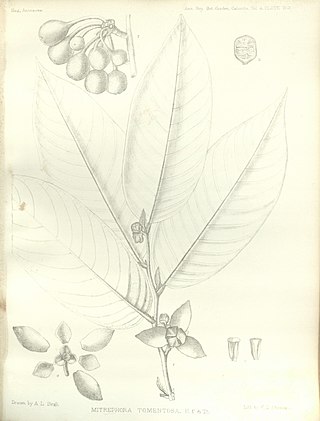
Mitrephora tomentosa is a species of plant in the family Annonaceae. It is native to Bangladesh, Cambodia, Laos, Myanmar, Thailand, and Vietnam. Joseph Hooker and Thomas Thomson, the British botanists who first formally described the species, named it after the dense covering of hair on its young branches, leaves and flowers.
Annona moaensis is a species of plant in the family Annonaceae. It is endemic to Cuba. Frère León and Henri Alain Liogier, the botanists who first formally described the species, named it after Moa, Cuba where the specimen they observed was collected.
Asteranthe lutea is a species of plant in the genus Asteranthe. It is native to Tanzania. Kaj Borge Vollesen, the botanist who first formally described the species in 1980, named it after its yellow petals.
Duckeanthus is a genus of plant in the family Annonaceae. It is native to Brazil. It contains a single species, Duckeanthus grandiflorus. Robert Elias Fries, the Swedish botanist who first formally described it, named it in honor of Adolpho Ducke who collected the specimen he examined, and its large flowers.
Pseuduvaria costata is a species of plant in the family Annonaceae. It is native to New Guinea. Rudolph Scheffer, the Dutch botanist who first formally described the species using the basionym Orophea costata, named it after its prominently ribbed fruit.
Pseuduvaria mollis is a species of plant in the family Annonaceae. It is native to New Guinea. Otto Warburg, the German-Jewish botanists who first formally described the species using the basionym Goniothalamus mollis, named it after the soft hairs on its leaves and petals.
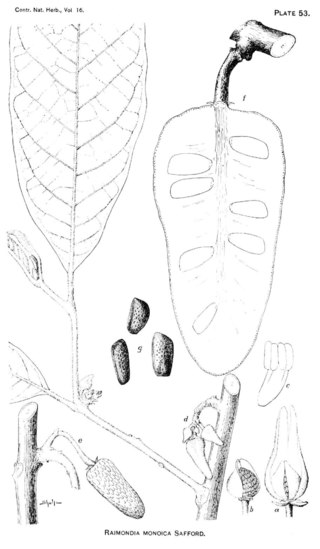
Annona cherimolioides is a species of plant in the Annonaceae family. It is native to Colombia and Ecuador. José Jerónimo Triana and Jules Émile Planchon, the botanists who first formally described the species, named it after its resemblance to another Annona species A. cherimoya.

Batesanthus pseudopalpus is a species of plant in the Apocynaceae family. It is native to the Republic of the Congo and Gabon. Hendrik J. T. Venter and Rudolf L. Verhoeven, the botanists who first formally described the species, named it after the lobes of its corona which they said resemble the pedipalps of the rain spiders Palystes castaneus and Palystes superciliosus.

Buckollia volubilis is a species of plant in the Apocynaceae family. It is native to the Ethiopia, Kenya, Somalia, Tanzania and Uganda. Rudolf Schlechter, the botanist who first formally described the species, named it after its twining growth habit, using the synonymous name Raphionacme volubilis.

Chlorocyathus lobulata is a species of plant in the Apocynaceae family. It is native to the Cape Provinces of South Africa. Hendrik J. T. Venter and Rudolf L. Verhoeven, the botanists who first formally described the species named it, using the synonym Raphionacme lobulata, after the distinctive lobes of the corona of its flowers.

Chlorocyathus monteiroae is a species of plant in the Apocynaceae family. It is native to Angola, Kenya, Mozambique, Namibia, South Africa, Tanzania and Zimbabwe. Daniel Oliver, the botanist who first formally described the species named it after Rose Monteiro who collected the specimen he examined from Maputo Bay.
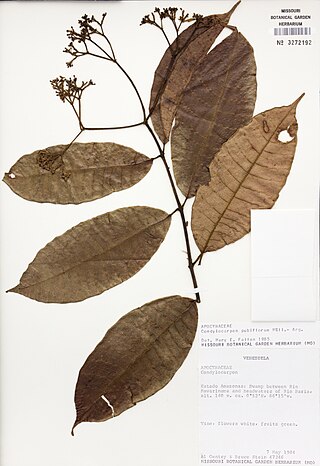
Condylocarpon pubiflorum is a species of plant in the Apocynaceae family. It is native to Bolivia, Brazil, Colombia, Peru and Venezuela. Johannes Müller Argoviensis, the botanist who first formally described the species, named it after an invalid nomen nudum, Hortsmania pubiflora, previously offered by George Bentham.
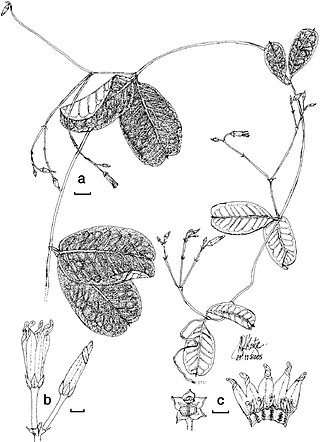
Cryptolepis africana is a species of plant in the Apocynaceae family. It is native to Kenya. Arthur Allman Bullock, the botanist who first formally described the species, using the synonymous subspecies name Cryptolepis sinensis subsp. africana, named it after the location where the sample he examined was collected in East Africa.












